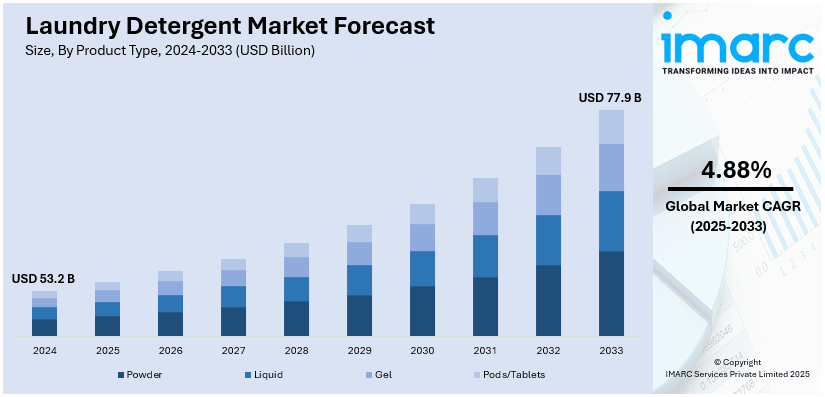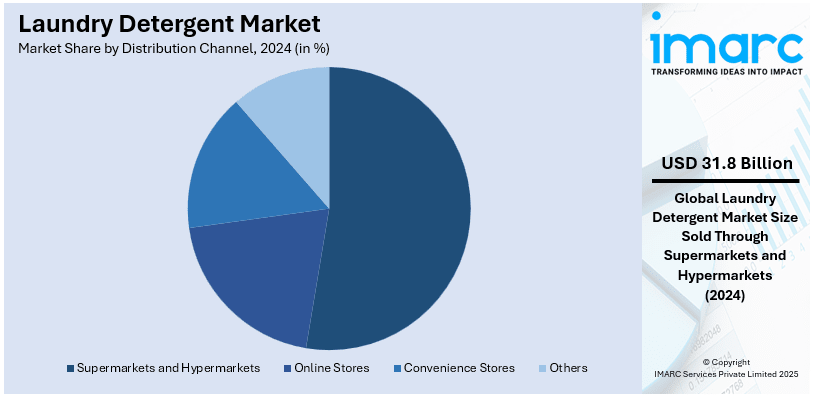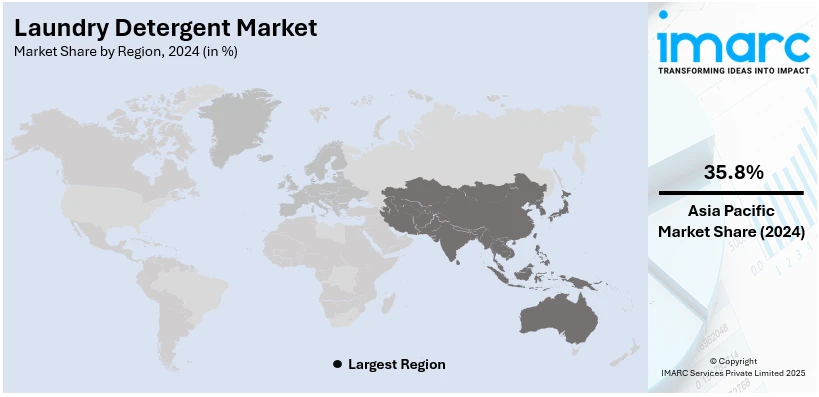
Laundry Detergent Market Size, Share, Trends and Forecast by Product Type, Distribution Channel, Application, and Region, 2025-2033
Laundry Detergent Market Size and Share:
The global laundry detergent market size was valued at USD 53.2 Billion in 2024. Looking forward, IMARC Group estimates the market to reach USD 77.9 Billion by 2033, exhibiting a CAGR of 4.88% from 2025-2033. Asia Pacific currently dominates the market, holding a market share of over 35.8% in 2024. The market is growing steadily, driven by rising hygiene awareness, urbanization, and innovation in eco-friendly and concentrated formulations. E-commerce expansion and changing consumer preferences are further boosting demand, contributing to the overall increase in global laundry detergent market share.
|
Report Attribute
|
Key Statistics |
|---|---|
|
Base Year
|
2024
|
|
Forecast Years
|
2025-2033
|
|
Historical Years
|
2019-2024
|
|
Market Size in 2024
|
USD 53.2 Billion |
|
Market Forecast in 2033
|
USD 77.9 Billion |
|
Market Growth Rate 2025-2033
|
4.88% |
Key drivers in the laundry detergent market include rising urbanization, increasing hygiene awareness, and higher disposable incomes, particularly in emerging economies. Growth in the hospitality, healthcare, and textile sectors also boosts demand for both liquid and powder detergents. Consumers are seeking efficient, convenient, and fabric-friendly products, encouraging innovation in concentrated formulas and eco-friendly ingredients. For instance, in September 2023, Hindustan Unilever (HUL) unveiled a pioneering technology to produce environment-friendly soda ash and silicate for laundry detergents, aiming to eliminate emissions via Green Ammonia. This initiative, announced during the Clean Future Summit, strengthens HUL's commitment to sustainability while enhancing product performance and affordability. Expanding e-commerce and retail channels further support product accessibility. Additionally, brand marketing and packaging improvements are influencing consumer choices, sustaining momentum in the global laundry detergent market.

Key drivers in the United States laundry detergent market include growing demand for high-efficiency and eco-friendly formulations, driven by environmentally conscious consumers. The rise in dual-income households and busy lifestyles is fueling preference for convenient options like pods and all-in-one solutions. For instance, in March 2025, Dropps launched its 4-in-1 Plus Oxi Biobased Power Laundry Detergent Pods at Target, expanding its reach in home care. This USDA Certified product combines sustainability and performance. Increased usage of washing machines, especially high-efficiency models, is influencing product innovation. Brand loyalty, aggressive marketing, and expanded availability through e-commerce and big-box retailers also support market growth, while consumers continue to prioritize performance, scent, and skin-sensitive formulations.
Laundry Detergent Market Trends:
Innovative Packaging Solutions
The rising focus on convenience is stimulating the market. As a result, companies are introducing packaging formats, such as strips, pods, dissolvable sachets, etc., which minimize the risk of overuse and offer pre-measured doses, thereby strengthening the market. For instance, in February 2024, Whirlpool Corporation launched laundry detergent with an ultra-concentrated and simple-to-use formula. Moreover, it has a re-engineered auto-stop top for even easier dosing. This is propelling the laundry detergent market demand.
Increasing Focus on Hygiene
Consumers across countries are seeking products that not only clean but also sanitize their clothes, thereby providing an extra layer of protection against germs. Consequently, brands are responding by launching detergents with improved antibacterial formulas and marketing them as essential for maintaining hygiene. This shift is further supported by heightened post-pandemic awareness, growing health consciousness, and increased demand for multi-functional home care products. As innovation continues in antibacterial and fabric-care technologies, these factors are expected to strongly influence the global laundry detergent market outlook.
Rising Product Offerings
The shifting preferences for cost-effective and space-saving solutions are propelling the market. Concentrated detergents require smaller doses per load and utilize less packaging, making them both economical and environmentally friendly. These formulations are specifically designed to work effectively in high efficiency washing machines, which use less water and energy. Consumers are also drawn to the ease of storage and reduced plastic waste, aligning with broader sustainability goals. The growing availability of concentrated options in both liquid and pod formats is further boosting market demand.
Laundry Detergent Industry Segmentation:
IMARC Group provides an analysis of the key trends in each segment of the global laundry detergent market, along with forecast at the global, regional, and country levels from 2025-2033. The market has been categorized based on product type, distribution channel, and application.
Analysis by Product Type:
- Powder
- Liquid
- Gel
- Pods/Tablets
Powder stand as the largest product type in 2024, holding around 32.6% of the market. Powder detergents hold the largest share in the laundry detergent market due to their cost-effectiveness, longer shelf life, and strong cleaning capabilities, especially for heavily soiled clothes. Widely used in both residential and commercial laundry settings, powders are often preferred in regions with hard water, as they include water softeners that enhance cleaning efficiency. Their affordability and bulk packaging options appeal to price-sensitive consumers, particularly in developing markets, contributing to their continued dominance across the global product type segmentation.
Analysis by Distribution Channel:

- Supermarkets and Hypermarkets
- Online Stores
- Convenience Stores
- Others
Supermarkets and hypermarkets leads the market with around 59.8% of market share in 2024. Supermarkets and hypermarkets offer extensive product ranges, wide distribution networks, and convenience. Chains like Tesco and Walmart have a wide array of budget options, which is bolstering the segment. These retail formats allow consumers to compare multiple brands and product types in one place, often benefiting from in-store promotions and bulk purchase discounts. Their strong supply chain capabilities ensure product availability, making them a preferred choice for routine household shopping, thereby supporting sustained growth in detergent sales through this channel.
Analysis by Application:
- Industrial
- Household
The household segment leads the laundry detergent market, driven by consistent and recurring demand from residential users for daily or weekly laundry care. Rising awareness about hygiene, increasing urbanization, and the widespread use of washing machines in homes are key contributors to this dominance. Consumers prioritize performance, fragrance, and fabric care, prompting brands to innovate with specialized and skin-friendly formulations. The growing availability of detergent variants tailored for home use further strengthens the household segment’s position as the market leader.
Regional Analysis:

- North America
- United States
- Canada
- Asia Pacific
- China
- Japan
- India
- South Korea
- Australia
- Indonesia
- Others
- Europe
- Germany
- France
- United Kingdom
- Italy
- Spain
- Russia
- Others
- Latin America
- Brazil
- Mexico
- Others
- Middle East and Africa
In 2024, Asia-Pacific accounted for the largest market share of over 35.8%. Asia-Pacific holds the largest market share in the laundry detergent market, supported by its vast population base, rapid urbanization, and rising disposable incomes. Countries like China, India, and Indonesia are key contributors due to growing middle-class households and increased adoption of washing machines. Regional consumers show strong demand for both traditional powders and newer liquid or pod formats. Additionally, expanding retail networks, local manufacturing capabilities, and aggressive marketing by both global and domestic brands continue to reinforce Asia-Pacific’s dominant position in the global market.
Key Regional Takeaways:
North America Laundry Detergent Market Analysis
The North America laundry detergent market continues to expand, driven by rising demand for convenient and multifunctional cleaning solutions across residential and commercial sectors. While the United States dominates the regional market, Canada and Mexico are also witnessing steady growth due to increased urbanization, rising disposable income, and higher adoption of automatic washing machines. Consumers are showing preference for concentrated and eco-friendly formulations, prompting manufacturers to innovate with biodegradable, phosphate-free, and dermatologically tested products. E-commerce plays a significant role, supported by subscription models, personalized offers, and fast delivery services. Major retailers and direct-to-consumer brands are optimizing online platforms to boost detergent sales, especially among younger, tech-savvy consumers. The region’s strong regulatory focus on sustainability is encouraging brands to invest in recyclable packaging and green ingredients. These factors collectively support robust North America laundry detergent market growth and diversification.
United States Laundry Detergent Market Analysis
In 2024, the United States accounted for over 79.80% of the laundry detergent market in North America. The United States sees rising demand for laundry detergent due to the growing online e-commerce platform, which enhances accessibility and convenience. For instance, the detergents e-commerce market in the U.S. is predicted to reach USD 5,515.8 Million in revenue by 2025, reflecting an estimated growth rate of 12% compared to 2024. Consumers increasingly opt for digital shopping, driving higher sales across various detergent formats. Subscription-based detergent services and bulk purchasing options further strengthen this trend. Promotional discounts and personalized recommendations encourage frequent purchases, boosting market penetration. Mobile commerce and app-based shopping experiences enhance detergent brand visibility. The growing e-commerce platform enables direct-to-consumer sales, reducing dependency on traditional retail. Expanding same-day and next-day delivery services cater to fast-paced lifestyles, fostering detergent consumption. Digital payment solutions simplify transactions, supporting impulse buying. Competitive pricing through online-exclusive deals increases affordability. Widespread product availability and seamless checkout experiences fuel laundry detergent adoption across diverse consumer segments.
Europe Laundry Detergent Market Analysis
In Europe, the increasing number of laundry detergent companies is fuelling intense competition, prompting innovation in formulations and sustainable packaging. For instance, the detergents and maintenance products sector in Europe plays a significant role in the economy, boasting an annual market value of €42.8 billion as of 2024. Consumer preference for eco-friendly and biodegradable products is driving demand for plant-based and non-toxic detergents. This increase in local and regional players is intensifying competition, encouraging innovation in product formulations, eco-friendly ingredients, and cost-effective options. Growing laundry detergent adoption is further fuelled by heightened awareness of hygiene and fabric care among consumers. Demand is also supported by the expanding urban population and the prevalence of washing machines in households. Regulatory support for biodegradable and low-phosphate detergents is prompting companies to invest in sustainable solutions. Private label brands by European retailers are also gaining traction, offering affordable choices. The combination of these factors is fostering robust market expansion and attracting new entrants across the continent.
Latin America Laundry Detergent Market Analysis
Latin America witnesses heightened laundry detergent adoption, propelled by growing household and disposable income, enabling consumers to purchase high-quality detergents. For instance, Brazil laundry care products market, in 2023, witnessed an Herfindahl-Hirschman (HHI) of 1666, which increased slightly as compared to the HHI of 1437 in 2017. Improved economic conditions expand detergent accessibility across income segments. The growing household and disposable income influence detergent preferences, fostering demand for specialized formulations. Increased spending power supports larger detergent pack sizes, catering to bulk-buying behaviors. Evolving consumer habits prioritize stain removal efficiency and long-lasting fragrance. Expanding detergent brand portfolios offer diverse options for varying budgets.
Middle East and Africa Laundry Detergent Market Analysis
Middle East and Africa observe rising laundry detergent consumption, attributed to growing e-commerce platforms and supermarkets and hypermarkets, ensuring widespread product availability. For instance, in the UAE detergents retail market, the online share is 42.8% and will increase by an average of 7.6% to 57.4% by 2029. Consumers benefit from detergent variety, competitive pricing, and promotional offers. The growing supermarkets and hypermarkets enhance detergent accessibility in urban and suburban areas. Expanded retail infrastructure facilitates bulk detergent purchases. Strategic detergent placement influences impulse buying.
Competitive Landscape:
The global laundry detergent market is highly competitive, with numerous international and regional players vying for consumer attention through innovation, pricing strategies, and brand positioning. Leading companies compete by introducing eco-friendly formulations, skin-sensitive variants, and advanced fragrance technologies. Private label brands are gaining ground, offering cost-effective alternatives with improved quality. E-commerce expansion allows both established and emerging brands to reach broader audiences directly. Marketing strategies emphasize convenience, performance, and sustainability to appeal to shifting consumer preferences. Continuous investment in research, product differentiation, and packaging innovation plays a key role in strengthening market presence and building long-term customer loyalty.
The report provides a comprehensive analysis of the competitive landscape in the laundry detergent market with detailed profiles of all major companies, including:
- Amway Corporation
- BASF SE
- Church & Dwight Co. Inc.
- Dow Inc.
- DuPont de Nemours Inc.
- Henkel AG & Co. KGaA
- Kao Corporation
- Lion Corporation
- Procter & Gamble Company
- Reckitt Benckiser Group PLC,
- The Clorox Company
- Unilever plc.
Latest News and Developments:
- January 2025: Unilever’s Appraisal Lab in the UK housed 80 washing machines to test laundry detergents under real-world conditions. The facility runs over 700 wash cycles daily to ensure top performance for global consumers. Experts assess brands like Dirt Is Good and Surf to meet diverse market needs. This rigorous testing guarantees superior cleaning for customers worldwide.
- June 2024: Whirlpool India has partnered with Hindustan Unilever in a joint marketing initiative aimed at improving the laundry experience in India. The collaboration integrates Whirlpool's advanced washing machines with Hindustan Unilever's Surf Excel, for superior cleaning. This initiative focuses on innovation and customer satisfaction. It aims to transform laundry with cutting-edge technology and quality products.
- May 2024: Persil introduced a specialized laundry detergent, Persil® Activewear Clean, tailored for athleticwear, athleisure, and synthetic fabrics. This variant aims to effectively remove sweat, odor, and stains while preserving fabric elasticity. The formula is designed to work efficiently even in low-temperature washes. With this launch, Persil targets active consumers seeking advanced fabric care solutions.
- April 2024: Unilever introduced Wonder Wash, a high-performance laundry detergent designed specifically for short cold cycles. This innovative formula ensures deep cleaning even within a rapid 15-minute wash cycle. It is engineered to dissolve quickly and remove stains effectively, catering to busy lifestyles. Wonder Wash sets a new benchmark for efficiency in fast-paced household laundry solutions.
Laundry Detergent Market Report Scope:
| Report Features | Details |
|---|---|
| Base Year of the Analysis | 2024 |
| Historical Period | 2019-2024 |
| Forecast Period | 2025-2033 |
| Units | Billion USD |
| Scope of the Report |
Exploration of Historical Trends and Market Outlook, Industry Catalysts and Challenges, Segment-Wise Historical and Future Market Assessment:
|
| Product Types Covered | Powder, Liquid, Gel, Pods/Tablets |
| Distribution Channels Covered | Supermarkets and Hypermarkets, Online Stores, Convenience Stores, Others |
| Applications Covered | Industrial, Household |
| Regions Covered | Asia Pacific, Europe, North America, Latin America, Middle East and Africa |
| Countries Covered | United States, Canada, Germany, France, United Kingdom, Italy, Spain, Russia, China, Japan, India, South Korea, Australia, Indonesia, Brazil, Mexico |
| Companies Covered | Amway Corporation, BASF SE, Church & Dwight Co. Inc., Dow Inc., DuPont de Nemours Inc., Henkel AG & Co. KGaA, Kao Corporation, Lion Corporation, Procter & Gamble Company, Reckitt Benckiser Group PLC, The Clorox Company, Unilever plc, etc. |
| Customization Scope | 10% Free Customization |
| Post-Sale Analyst Support | 10-12 Weeks |
| Delivery Format | PDF and Excel through Email (We can also provide the editable version of the report in PPT/Word format on special request) |
Key Benefits for Stakeholders:
- IMARC’s report offers a comprehensive quantitative analysis of various market segments, historical and current market trends, market forecasts, and dynamics of the laundry detergent market from 2019-2033.
- The research study provides the latest information on the market drivers, challenges, and opportunities in the global laundry detergent market.
- The study maps the leading, as well as the fastest-growing, regional markets. It further enables stakeholders to identify the key country-level markets within each region.
- Porter's Five Forces analysis assists stakeholders in assessing the impact of new entrants, competitive rivalry, supplier power, buyer power, and the threat of substitution. It helps stakeholders to analyze the level of competition within the laundry detergent industry and its attractiveness.
- Competitive landscape allows stakeholders to understand their competitive environment and provides an insight into the current positions of key players in the market.
Key Questions Answered in This Report
The laundry detergent market was valued at USD 53.2 Billion in 2024.
IMARC estimates the laundry detergent market to reach USD 77.9 Billion by 2033, exhibiting a CAGR of 4.88% from 2025-2033.
Key factors driving the laundry detergent market include rising hygiene awareness, increasing urbanization, higher washing machine adoption, and growing demand for eco-friendly and concentrated products. Expanding e-commerce, innovative packaging, and changing consumer lifestyles are also encouraging frequent purchases and boosting overall market growth.
Asia Pacific currently dominates the laundry detergent market, driven by its large population, growing urban households, rising disposable incomes, and increased washing machine usage. Strong demand in countries like China, India, and Indonesia continues to support the region’s leading laundry detergent market share.
Some of the major players in the laundry detergent market include Amway Corporation, BASF SE, Church & Dwight Co. Inc., Dow Inc., DuPont de Nemours Inc., Henkel AG & Co. KGaA, Kao Corporation, Lion Corporation, Procter & Gamble Company, Reckitt Benckiser Group PLC, The Clorox Company, Unilever plc,etc.
Need more help?
- Speak to our experienced analysts for insights on the current market scenarios.
- Include additional segments and countries to customize the report as per your requirement.
- Gain an unparalleled competitive advantage in your domain by understanding how to utilize the report and positively impacting your operations and revenue.
- For further assistance, please connect with our analysts.
 Request Customization
Request Customization
 Speak to an Analyst
Speak to an Analyst
 Request Brochure
Request Brochure
 Inquire Before Buying
Inquire Before Buying




.webp)




.webp)












